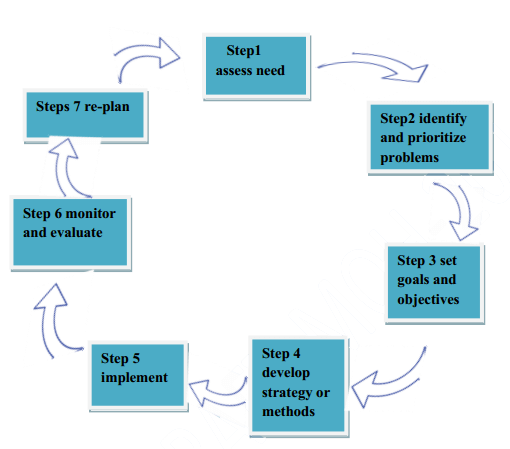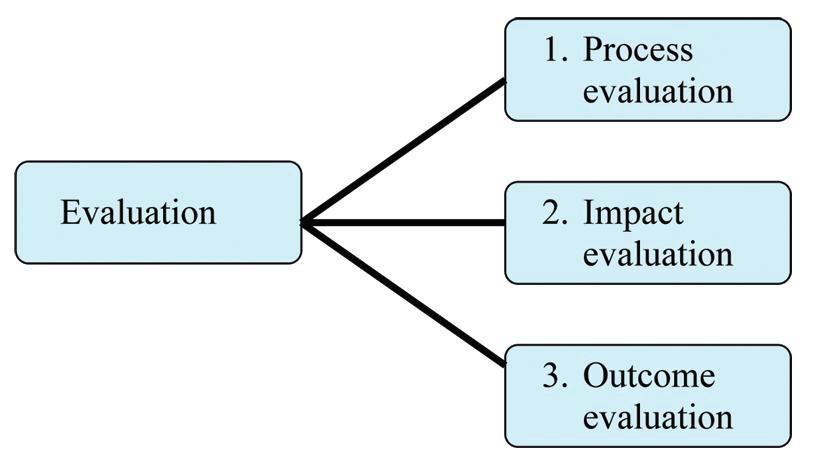

In previous session, you have already learned about need assessment and data collection techniques. Here you need to consider it as one step in planning health education and health promotion activities and programs. So you should recall what you have learned in the previous session. Conducting a need assessment is the first, and probably the most important, step in any successful planning process. A needs assessment is a systematic process for determining and addressing needs, or "gaps" between current conditions and desired conditions or "wants". The discrepancy between the current condition and wanted condition must be measured to appropriately identify the need...
Community health needs assessment is a process that describes the state of health of local people; enables the identification of the major risk factors and causes of ill health, and enables the identification of the actions needed to address these.
a. The community and its general socio-economic, demographic and physical characteristics--- Here you are dealing with the size of the community (average size of the household) and their sex and age group, Average number of pregnancies, births and deaths,the economy and its impact on health, religion and its impact on health, kind of natural resources existing in the community, the transportation routes and the communication network and public and private institutions like schools, religious institutions, health facilities.
b. Health beliefs and practices--- cultural beliefs, attitudes and practices of the community have great influences on the delivery of the health services. Bearing this in mind your assessment result should address how people define good health and disease, the methods used to help maintain their health and other beliefs, attitudes and practices concerning each health service extension packages.
This step is logically done after the need assessment is completed. From the need assessment result, it is possible to identify and list some community health problems and their potential causes. For example, you can identify such a health problems as HIV/AIDs, Malaria, Tuberculosis, diarrheal disease among under-five children, pneumonia hypertension, and diabetes mellitus in your community.
Identification of the possible causes of disease and another health problem is another activity, and it addresses scientific and cultural perspectives as a cause of a certain disease. For example, you have the probability to identify the cause for HIV/AIDs---curse of supernatural beings. Do you think it would be possible to act up on all the identified problems?. Discuss in the group and come-up with some suggestions and conclusions.
The next step after identifying of the list of problems is prioritisation-- it is a kind of decisions made to put the identified problem (s) in the order of their urgency, importance and changeability. However, the decision is not haphazard or arbitrary. There are five basic criteria to prioritise these problems. Look at the following (box 6.6) shows the basic five criteria for problem identification
Listing the criteria does not mean that the problem is already prioritised and ready for an intervention. Rather scoring the points from one to five to each of the problems makes the prioritisation process easier. A score of one is the minimum value, and the problem is given less concern, and a score of five is the maximum, and it means the problem is given more concern. Finally, the values are added, and the total is known, and then ranks the problem with a largest total value first and so on. Look at the following table 6.7 shows the scoring process in problem prioritisation.
| Problems Identified | Score for Each Criterion | Total Value | Rank | |||||
|---|---|---|---|---|---|---|---|---|
| Magnitude | Severity | Feasibility | Community Concern | Government Concern | ||||
| 1 | HIV/AIDs | 5 | 5 | 4 | 3 | 5 | 22 | 3 |
| 2 | Tuberculosis | 5 | 5 | 4 | 5 | 5 | 24 | 2 |
| 3 | Malaria | 5 | 5 | 5 | 5 | 5 | 25 | 1 |
| 4 | Diarrheal disease | 3 | 3 | 5 | 3 | 5 | 19 | 5 |
| 5 | Pneumonia | 5 | 5 | 3 | 2 | 5 | 20 | 4 |
| 6 | Hypertension | 4 | 3 | 4 | 2 | 4 | 17 | 7 |
| 7 | Diabetes mellitus | 4 | 3 | 4 | 3 | 4 | 18 | 6 |
The second option you have available in prioritising health problems is to ask a group of stakeholders, such as community members or other health workers, to prioritise the problems according to their knowledge and experience. How many problems do you select to address?. That depends on your capacity and the resources you have to deal with them.
Setting Goals and Objectives
As soon as the problems are prioritised, your next duty will be setting appropriate goals and objectives. Both terms imply the target that one's efforts are desired to accomplish. Goals are generically for an achievement or accomplishment for which certain efforts are put.
For example 'The Millennium Development Goals' health educations Objectives are specific targets within the general goal. If you do not have objectives, you cannot evaluate the effectiveness and efficiency of your health education activities. Objectives are time-related to achieve a certain task, and answer the following questions:
The extent of achievements: Can you measure the improvement in health that you have achieved? The objective should be 'SMART'--it is an abbreviation and stands for the following five criteria of good objectives S-specific M- Measurable A- Achievable R- Relevant T- Time-bound.
Types of Objectives in Health Education
Once a health extension worker understands the reason behind behaviour that is causing a health problem, she can use many different methods/strategies to encourage a change in that behaviour.There are some basic issues to consider before choosing health education methods/strategies.
Develop Your Work Plan or Action Plan
A plan of work is simply putting together all the components you have worked out to deliver your health education messages. It is a picture or "map" of what to do when to do it, who will do it, and at what cost each step of activities be accomplished. The plan should contain the following elements:
Implement Health Education Program
Implementation is a process of bringing the planned activities into action. Or it is converting your planning, objectives and strategies into action according to the plan of work
It is an ongoing process of collecting and analysing data on actual implementation of the program so that any deviations from the planned operations are detected, diagnosis for causes of deviation is carried out, and suitable corrective actions are taken. Monitoring can take place at any time during the implementation process, on a regular or periodic basis. For instance, you will be able to monitor your activities daily, fortnightly or monthly, or as the need arises. You need to monitor the progress of your health education activities by making periodic visits to the households or any other health education activity settings

It is the systematic collection, analysis and reporting of information about health education activities. It is a systematic way of learning from experience and using the lessons learnt to improve current activities and promote better planning by careful selection of alternatives for future action. Evaluating is making judgments about the current status of health education objectives.While you are evaluating health education activities you need to raise the following questions:
Health education evaluation is carried out mainly to check program effectiveness and efficiency. Effectiveness-- refers to the extent to which you have achieved your goals and objectives (health objectives, learning objectives, behavioural objectives or resource objectives). Efficiency--- means the extent to which you have achieved your objectives with the available amount of resources. In other words, it refers to the proper utilisation of resources when achieving your health education objectives.

This form of evaluation assesses the immediate effect of the program or change in behaviour (knowledge, attitude and skills) at the end of each health education programs.
Outcome evaluation assesses the long-term effect of the health education program, and you need to assess the decrease in morbidity, mortality and also disability among the target audiences as a result of the health education program. Outcome evaluation assesses the effectiveness as well as the efficiency of the goal/objective at the end of the program.
Follow the following six steps to evaluate your health education activities:
Step1. Involve the local people in the process of evaluation.
Step2. Describe the type of health education activity you want to evaluate.
Step3. Select the evaluation methods.
Step4. Collect the important data on the selected activity by using data collection techniques you learnt in your need assessment phase.
Step5. Analyse and interpret the data in meaningful ways.
Step6. Learn from the evaluation--objective achieved or failed? What do you want to do in the future?.